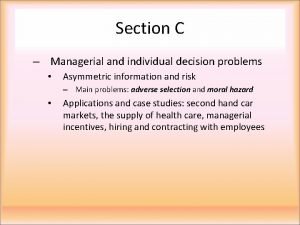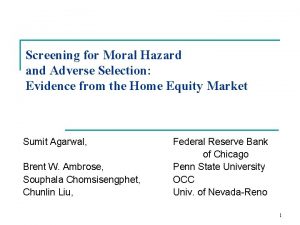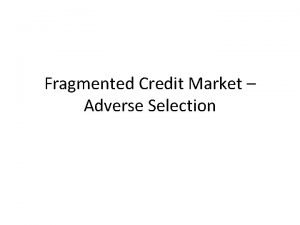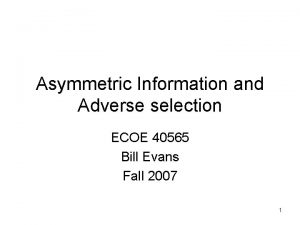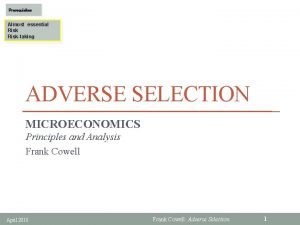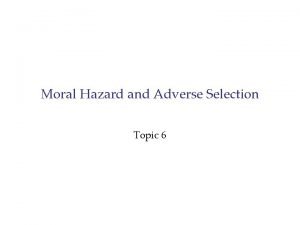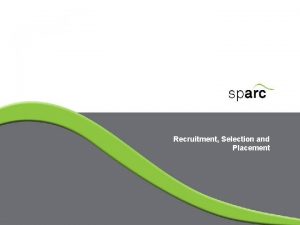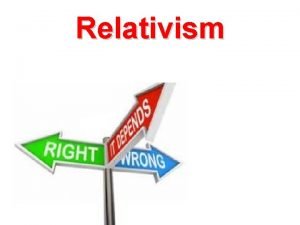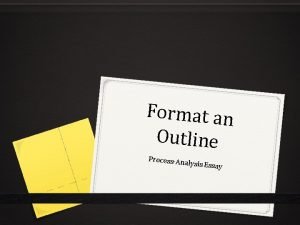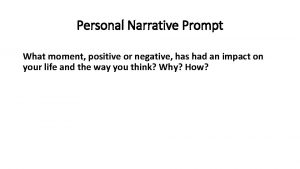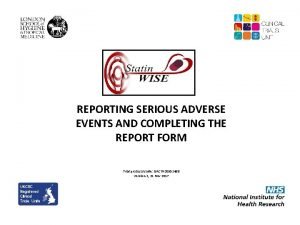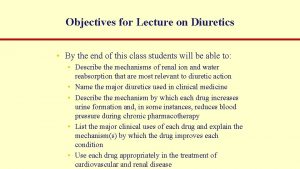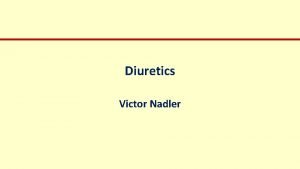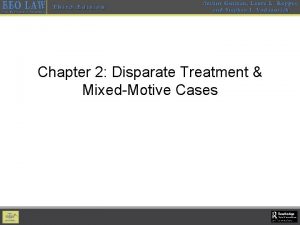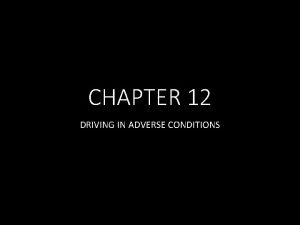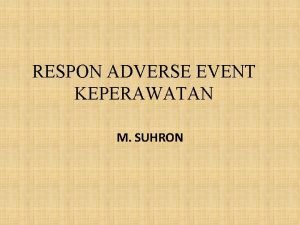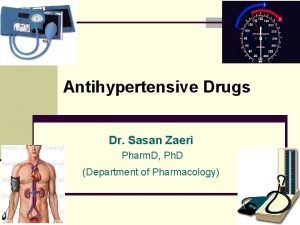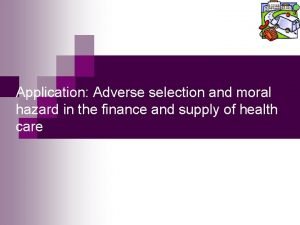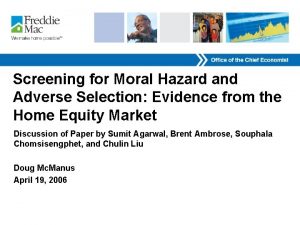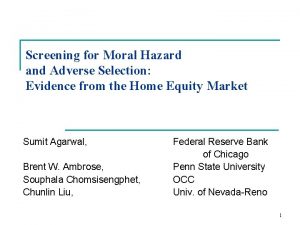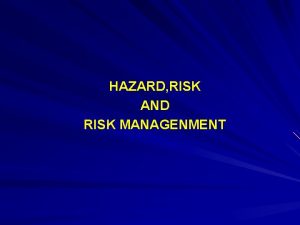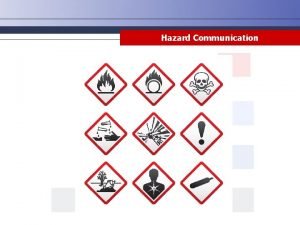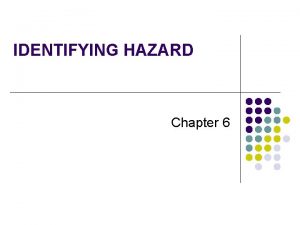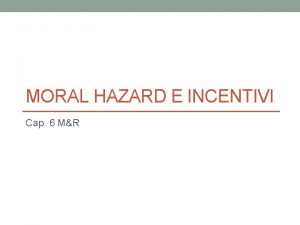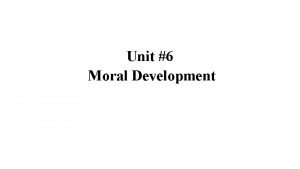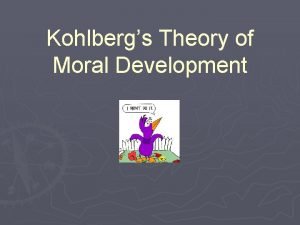Moral Hazard and Adverse Selection Topic 6 Outline



























































- Slides: 59

Moral Hazard and Adverse Selection Topic 6

Outline 1. 2. 3. 4. Government as a Provider of Insurance. Adverse Selection and the Supply of Insurance. Moral Hazard and Incentives in Organizations.

1. Insurance Elements of the Welfare State The government collects taxes as a compulsory insurance. In return citizens may get: • Unemployment insurance & Disability insurance. • Health provision • State Pension • Social care for the elderly & infirm. Key Features of this “implicit contract” are: • The payout is dependent on contingencies such as ill health or unemployment. • The payout may depend on how much was contributed. • Contributions to the scheme are obligatory – merit good. • There is an element of redistribution.

Why State-Provided Insurance? What are inefficiencies that arise when the private sector provides insurance. 1. Transactions Costs: Privately-run pension insurance schemes are not as efficient as state-run schemes - 6% costs rather than 1%. 2. Systemic or Social Risk: Some risks are so enormous they cannot be diversified. Need to be able to borrow potentially unlimited amounts to insure against them. (Disasters, Wars, inflation). 3. Externalities: Want people to get health care to stop communicable diseases, also people get a warm-glow from ensuring others’ health (caring externality). 4. Adverse Selection: Profitable only to insure the healthy, short-lived etc. (How do AIDS patients get private health care? ) 5. Moral Hazard: Retirement is a choice, providing pensions affects this choice in potentially harmful ways. (If retirement provision is very generous people don’t save enough, and retire too early. )

Why Not State Provided Insurance? • “Pay-as-you-go” versus “Fully-funded” schemes. => Fiscal crises, longevity. • Disincentive to save. “Nanny state mentality”. • Labour supply. Reduced incentive to work – smaller labour force… • Reduced rate of return on government investment rather than private investment. • Moral hazard: If you offer full insurance individuals have a reduced incentive to avoid risks. For example, they may be less responsible employees if they know they will always receive full unemployment insurance if they are fired.

2. Adverse Selection Some important concepts that we will use when we discuss Adverse Selection and Moral Hazard. Actuarially-Fair Insurance: You have 1 1/1000 chance of having a week’s illness in the next year. This will cost you £ 500 in lost earnings. How much would it cost to insure against this? If premium = £ 0. 50 = £ 500 x (1/1000 ) Then the insurance is said to be actuarially fair. If the premium is >£ 0. 50 then it is not actuarially fair!

Risk Aversion You have two choices: (1) A gamble which pays OR (2) A certain payment of £x. Which do you choose? £ 10 with probability ½ -£ 2 with probability ½. Expected = ½(10)+½(-2) =4

Risk Aversion The “expected value” of the first gamble is ½ (10)+ ½ (-2) = £ 4. If you choose £x for sure for some x<4 you are said to be risk averse.

Risk Aversion The “expected value” of the first gamble is ½ (10)+ ½ (-2) = £ 4. If you choose £x for sure for some x<4 you are said to be risk averse. You are prepared to lose on average 4 -x in return for not having to have any risk. Or, you are prepared to pay at least 4 -x to some company to take the risk away!

Risk Aversion The “expected value” of the first gamble is ½ (10)+ ½ (-2) = £ 4. If you choose £x for sure for some x<4 you are said to be risk averse. You are prepared to lose on average 4 -x in return for not having to have any risk. Or, you are prepared to pay at least 4 -x to some company to take the risk away! If you are indifferent between the gamble and the sure thing when x=4 you are said to be risk neutral.

Risk Aversion The “expected value” of the first gamble is ½ (10)+ ½ (-2) = £ 4. If you choose £x for sure for some x<4 you are said to be risk averse. You are prepared to lose on average 4 -x in return for not having to have any risk. Or, you are prepared to pay at least 4 -x to some company to take the risk away! If you are indifferent between the gamble and the sure thing when x=4 you are said to be risk neutral. If you prefer the gamble when x>4 you are risk loving.

Evidence Most individuals with average wealth and good education tend to be risk neutral over small gambles. Over larger gambles individuals tend to be risk averse. (Except when buying lottery tickets. )

Evidence Most individuals with average wealth and good education tend to be risk neutral over small gambles. Over larger gambles individuals tend to be risk averse. (Except when buying lottery tickets. ) Large organizations: banks, insurance companies, firms tend to be risk neutral. Two reasons: (1) The risks are small relative to the organization’s size. (2) They have so many risky things that they on average tend to cancel each other out – “diversified risk”.

Insurance A risk averse individual will always be better off buying actuarially fair insurance.

Insurance A risk averse individual will always be better off buying actuarially fair insurance. As insurance becomes less fair (administration costs, deductibles, copays etc), risk averse individuals will buy less insurance.

Insurance A risk averse individual will always be better off buying actuarially fair insurance. As insurance becomes less fair (administration costs, deductibles, copays etc), risk averse individuals will buy less insurance. Who prefers to have large deductibles? - Rich or poor? - High or low risk? => Self selection problem for insurance companies.

Adverse Selection and Moral Hazard Insurance Companies generally have kinds of problems: (1) People come in different types: High risk/Low risk, Careful/sloppy, healthy/unhealthy. The customers know something the company doesn’t. = ADVERSE SELECTION

Adverse Selection and Moral Hazard Insurance Companies generally have kinds of problems: (1) People come in different types: High risk/Low risk, Careful/sloppy, healthy/unhealthy. The customers know something the company doesn’t. = ADVERSE SELECTION (2) People take actions the company does not see: Drive carefully/not, Exercise/not, work hard/not. The customers do something the company doesn’t. = MORAL HAZARD

Insurance and Adverse Selection • We are going to show that insurance markets in the presence of adverse selection will tend to be inefficient.

Insurance and Adverse Selection • We are going to show that insurance markets in the presence of adverse selection will tend to be inefficient. • This is an example of a market failure and government has a role in correcting this (either by regulation or by supplying insurance itself).

Insurance and Adverse Selection • We are going to show that insurance markets in the presence of adverse selection will tend to be inefficient. • This is an example of a market failure and government has a role in correcting this. • Hence we tend to observe state-provided (health etc. ) insurance. Problem: Only the bad types want to buy insurance.

Insurance and Adverse Selection Problem: Only the bad types want to buy insurance. L = Low risk types ½ of the population. H = High Risk types ½ of the population.

Insurance and Adverse Selection Problem: Only the bad types want to buy insurance. L = Low risk types ½ of the population. H = High Risk types ½ of the population. (1) Suppose insurers offer actuarially fair insurance, (assuming all the population buy insurance), then it is unattractive to the low risk types because they are paying too much compared to their odds. (“POOLING”)

Insurance and Adverse Selection Problem: Only the bad types want to buy insurance. L = Low risk types ½ of the population. H = High Risk types ½ of the population. (1) Suppose insurers offer actuarially fair insurance (assuming all the population buy insurance), then it is unattractive to the low risk types because they are paying too much compared to their odds. (“POOLING”) Þ (2) Not all low risk types buy insurance and actuarial rates in step (1) are wrong more than 50% high risk types!

Insurance and Adverse Selection Problem: Only the bad types want to buy insurance. L = Low risk types ½ of the population. H = High Risk types ½ of the population. (1) Suppose insurers offer actuarially fair insurance, (assuming all the population buy insurance) then it is unattractive to the low risk types because they are paying too much compared to their odds. (“POOLING”) Þ (2) Not all low risk types buy insurance and actuarial rates in step (1) are wrong more than 50% high risk types! Þ (3) Insurers should raise the price for insurance to reflect this.

Insurance and Adverse Selection Problem: Only the bad types want to buy insurance. L = Low risk types ½ of the population. H = High Risk types ½ of the population. (1) Suppose insurers offer actuarially fair insurance, (assuming all the population buy insurance) then it is unattractive to the low risk types because they are paying too much compared to their odds. (“POOLING”) Þ (2) Not all low risk types buy insurance and actuarial rates in step (1) are wrong more than 50% high risk types! Þ (3) Insurers should raise the price for insurance to reflect this. Þ (4) As price goes up again even fewer low risk types buy.

How Does this Cycle End? Can result in only the high risk types buying (very expensive) insurance and the low risks being unable to obtain it at reasonable rates.

How Does this Cycle End? Can result in only the high risk types buying (very expensive) insurance and the low risks being unable to obtain it at reasonable rates. Or, it may be that insurance companies offer contracts that offer less than full insurance and the low risk types. (“SEPARATING”) These are both market failures.

How Does this Cycle End? Can result in only the high risk types buying (very expensive) insurance and the low risks being unable to obtain it at reasonable rates. Or, it may be that insurance companies offer contracts that offer less than full insurance and the low risk types. (“SEPARATING”) These are both market failures. How could the government solve it? (1) Force everyone to buy private insurance – cars. (2) Offer insurance itself – health.

Private or Public Insurance? Pro State: In what areas of life would the inability of individuals to obtain adequate insurance be undesirable? - health - income - retirement?

Private or Public Insurance? Pro State: In what areas of life would the inability of individuals to obtain adequate insurance be undesirable? - health - income - retirement? Pro Private: Which would offer more variety and innovation – state or private?

Private or Public Insurance? Pro State: In what areas of life would the inability of individuals to obtain adequate insurance be undesirable? - health - income - retirement? Pro Private: Which would offer more variety and innovation – state or private? If some parts of the welfare state insurance is replaced by private insurance – what kind of a market would we want? Monopoly or Competitive.

Private or Public Insurance? Pro State: In what areas of life would the inability of individuals to obtain adequate insurance be undesirable? - health - income - retirement? Pro Private: Which would offer more variety and innovation – state or private? If some parts of the welfare state insurance is replaced by private insurance – what kind of a market would we want? Monopoly or Competitive. Are the private schemes redistributive? . . . .

Problems of Mixed/Contracting Out Schemes Public sector schemes tend to be redistributive: (i. e. greater benefits to the poor relative to the size of their contribution) Who will private providers of NI contributions, for example, tend to want to attract? What happens to the public scheme? Information Problems: Should we allow data on test results to be obtained.

3. Hidden Actions: Moral Hazard Economic relationships often have the form of a Principal who contracts with an Agent to take certain actions that the principal cannot observe directly. Principal Agent physician employer stockholder insurer bank patient employee manager insuree borrower Hidden Action exercise effort strategy caution effort

Examples: 1960's: dentists in the UK health service had a government contract that paid them for every cavity they drilled. What happened?

Examples: 1960's: dentists in the UK health service had a government contract that paid them for every cavity they drilled. What happened? A Building Contract A business contracts with a building firm to build it a new HQ. There is cost uncertainty – so the firm will reimburse the builder for allowable costs and a provision for normal rates of profit (a cost plus contract). Completion date is set for 2 years from now.

Examples: 1960's: dentists in the UK health service had a government contract that paid them for every cavity they drilled. What happened? A Building Contract A business contracts with a building firm to build it a new HQ. There is cost uncertainty – so the firm will reimburse the builder for allowable costs and a provision for normal rates of profit (a cost plus contract). Completion date is set for 2 years from now. 1. Adverse Selection Issues Builder may be inefficient and a cost-plus contract protects it. 2. Moral Hazard The contractor has no incentive to keep costs low under cost plus.

Example Volvo Drivers: It has been found that Volvo drivers run through STOP signs more often than drivers in other makes of car. Is this moral hazard or adverse selection? How would you test it?

Moral Hazard and Incentives How do you give people incentives to do the right thing? Structure some sort of contract…

Moral Hazard and Contracting Need a contract to enforce actions that the principal prefers. This is not a problem unless 3 conditions hold: 1. There is a divergence of interests. 2. There is a need for the individuals to transact. 3. There are observation problems.

What actions may be unobserved? 1. Employee’s effort. 2. How much investment a regulated firm is making. 3. How carefully individuals are preparing themselves for retirement. Usually the principal only receives a noisy signal of the effort expended (Output, accounts, profits) If the agent does not care about risk, the principal can give him incentives to behave efficiently (sell him the company!). If the agent does care about risk, then it is impossible!

Example Road Safety Principal: Government Agent: Drivers Why do the 3 conditions below hold? 1. Divergence of interests? . . 2. Need to transact? . . 3. Observation problems? . . . What is the observed signal? . . . What is it correlated with? . . .

General Conclusions It is easy to solve the moral hazard problem when agents are risk neutral and have unlimited liability (or are just very rich) – sell them the company!

General Conclusions It is easy to solve the moral hazard problem when agents are risk neutral and have unlimited liability (or are just very rich) – sell them the company! If they have limited liability (e. g. bank loans), are not rich or do care about risk its harder to give them incentives.

General Conclusions It is easy to solve the moral hazard problem when agents are risk neutral and have unlimited liability (or are just very rich) – sell them the company! If they have limited liability (e. g. bank loans), are not rich or do care about risk its harder to give them incentives. Limited liability generates an inefficiency, because some investments that should be made are not. (Second best).

How to provide incentives and what they cost. Recall there are 3 conditions necessary for moral hazard problems: 1. Different preferences. 2. Some need for trade. 3. Problems verifying/observing behavior. So if you can reduce these you can reduce the problems of moral hazard.

Problems Verifying & Observing Solution: devote more effort to monitoring. • Competition alone can generate monitoring information (league tables in the public sector). • Inter-employee comparisons. • Competition between internal and external suppliers.

Costs of Incentives Frequently observe something correlated with the action that you want to encourage.

Costs of Incentives Frequently observe something correlated with the action that you want to encourage. Problems: Sometime people put in effort but are just unlucky – this makes their life risky and they don’t like it.

Costs of Incentives Frequently observe something correlated with the action that you want to encourage. Problems: Sometime people put in effort but are just unlucky – this makes their life risky and they don’t like it. Introduces an inefficiency because it is usually better for the government to bear this risk not the individual.

Costs of Incentives Frequently observe something correlated with the action that you want to encourage. Problems: Sometime people put in effort but are just unlucky – this makes their life risky and they don’t like it. Introduces an inefficiency because it is usually better for the government to bear this risk not the individual. Want individuals to bear some risk (to give them incentives) but not too much to encourage them to participate.

Costs of Incentives Frequently observe something correlated with the action that you want to encourage. Problems: Sometime people put in effort but are just unlucky – this makes their life risky and they don’t like it. Introduces an inefficiency because it is usually better for the government to bear this risk not the individual. Want individuals to bear some risk (to give them incentives) but not too much to encourage them to participate. But should only make employees bear risk if it actually does give them incentives. Incentives – Make principal and agents’ objectives the same

Incentives and Risk Incentives => agents bear costly risk.

Incentives and Risk Incentives => agents bear costly risk. This may be inefficient if agents are risk averse but not if they are risk-neutral.

Incentives and Risk Incentives => agents bear costly risk. This may be inefficient if agents are risk averse but not if they are risk-neutral. Insurance contracts provide a balance between incentives and risk. Copays/deductibles allow individuals to be insured (reduce their risks) but still have incentives to take care.

Incentives and Risk Incentives => agents bear costly risk. This may be inefficient if agents are risk averse but not if they are risk-neutral. Insurance contracts provide a balance between incentives and risk. Copays/deductibles allow individuals to be insured (reduce their risks) but still have incentives to take care. Incentive contracts are similar. Here risk comes from: luck, bad performance evaluation, outside events

The 4 Factors for Optimal Incentives In setting up incentives the general message is you must balance (1) The increased benefit from better behaviour from agents. (2) The costs of risk borne by agents (risk aversion). (3) How precisely you can measure performance. (4) How much effort will increase in response to incentives anyway! Incentive Intensity Principle: Incentives should be most intense when agents are able to take actions to respond to them.

Traffic Safety Again What do you need to know if you are introducing speed cameras to control speed to improve road safety… (1) The increased benefit from better behaviour from agents…. ? (2) The costs of risk borne by agents (risk aversion)…. ? (3) How precisely you can measure performance…. ? (4) How much effort will increase in response to incentives anyway…?
 Bread sentence
Bread sentence Adverse selection
Adverse selection Adverse selection
Adverse selection Adverse selection
Adverse selection Adverse selection
Adverse selection Adverse selektion
Adverse selektion Adverse selection
Adverse selection What is adverse selection
What is adverse selection Tools to help solve adverse selection problems
Tools to help solve adverse selection problems International strife and league of nations
International strife and league of nations Moral hazard occurs when
Moral hazard occurs when Selezione avversa e azzardo morale
Selezione avversa e azzardo morale Moral hazard adalah
Moral hazard adalah Paragraph writing strategy
Paragraph writing strategy Topic down
Topic down Moral realism
Moral realism Two way selection and multiway selection in c
Two way selection and multiway selection in c Two way selection and multiway selection in c
Two way selection and multiway selection in c Mass selection and pure line selection
Mass selection and pure line selection Recruitment and selection course outline
Recruitment and selection course outline Moral relativism vs moral universalism
Moral relativism vs moral universalism Moral individu dan moral kelompok
Moral individu dan moral kelompok Moral de esclavos y moral de señores
Moral de esclavos y moral de señores Ib group dynamics
Ib group dynamics S
S A topic outline uses
A topic outline uses Dbq thesis formula
Dbq thesis formula Topic outline
Topic outline Digital topic outline
Digital topic outline Balancing selection vs stabilizing selection
Balancing selection vs stabilizing selection Artificial selection vs natural selection
Artificial selection vs natural selection K selected
K selected Natural selection vs artificial selection
Natural selection vs artificial selection Artificial selection vs natural selection
Artificial selection vs natural selection What is artificial selection
What is artificial selection What is exponential growth in ecology
What is exponential growth in ecology Natural selection vs artificial selection
Natural selection vs artificial selection Adverse reaction definition
Adverse reaction definition Near miss examples ppt
Near miss examples ppt Adverse reaction definition
Adverse reaction definition Adverse reaction definition
Adverse reaction definition Adverse events in hospital
Adverse events in hospital Adverse events in hospital
Adverse events in hospital Puerperal sepsis
Puerperal sepsis Acetaminophen mechanism
Acetaminophen mechanism Loop diuretics adverse effects
Loop diuretics adverse effects Mechanism of action of acetaminophen
Mechanism of action of acetaminophen Sitaglimet
Sitaglimet Azalastyna
Azalastyna Harley nadler
Harley nadler Loop diuretics adverse effects
Loop diuretics adverse effects Hayanil tablets
Hayanil tablets Adverse treatment
Adverse treatment To give yourself more time for the ipde process at night
To give yourself more time for the ipde process at night Driving in adverse conditions
Driving in adverse conditions Adverse event adalah
Adverse event adalah Fetal warfarin syndrome mnemonic
Fetal warfarin syndrome mnemonic Adverse effect of alpha blockers
Adverse effect of alpha blockers Beta blockers mechanism of action
Beta blockers mechanism of action Alpha blockers
Alpha blockers

